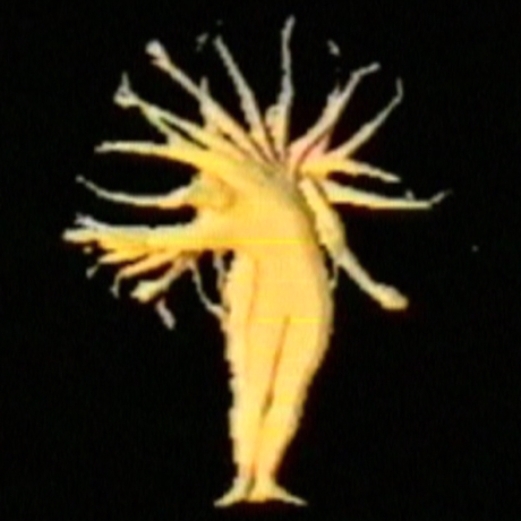











Hommage à E. M. – a Multimedia Dance Project
The digital ballet Hommage à E. M. premiered at the 1989 artware exhibition in Hanover and was dubbed the “highlight of the exhibition” by magazine Art in a report on the premiere. With the title Hommage à E. M. it honors the pioneer of photography: Eadweard Muybridge. He first captured human and animal movement in serial photographs more than a hundred years ago.


In Hommage àE. M., a dancer was recorded with a VHS video camera and the moving image was passed live to a Fairlight video computer, which digitalized the moving image in real time and processed it further in real time. Different programs were available, which could be called up by the video artist via a control panel and whose numerous parameters could be controlled live via sliders and knobs. The processed images were projected directly onto a screen by a projector behind the stage, so that the audience could observe both the dancer’s movements and the electronic “mirror image” created from them. With a small monitor at the front edge of the stage, the dancer could see the processing and thus enter into a creative interplay with the electronic image artist.


The video computer used for the Hommage, made by Fairlight, a company that otherwise produced audiosizers, did not succeed in the market. Only a few copies were produced before Fairlight soon stopped production.
Concept and visual design: Herbert W. Franke
Music: Klaus Netzle
Dramaturgy and Dance: Susanne Paech
Dancer: Claudia Knoll
Technique: Christoph Gruener
The historical background text to the 1989 premiere
Performance of a dancer with her electronic mirror image


The dynamic moment of movement is of fundamental importance in many forms of art – not least in dance. Through the use of modern media, dynamic processes can be grasped from a new perspective. Hints of this can be found in the works of Eadweard Muybridge, which have long since become classic, who used newly developed photographic methods to obtain phase images of motor processes in humans and animals. The possibilities of analytical examination of the phenomenon “movement” are considerably extended by modern electronic devices. This results not only in scientific knowledge but also in considerable aesthetic moments.
Technical basis
The main technical equipment used is a video camera, an image processing computer, and a video projector with a rearprojection screen. The video camera records the movement of the dancer and feeds it into the image transformer. The processing of the optical data takes place in real time; it is manually controlled according to prepared programs and thus also contains a decisive improvisational component.
Semantic basis
Basically, the presentation offers the viewer the opportunity to get to know “movement” in a way never seen before. Among other things, it results in the insight that the way the human eye and human visual perception record motor processes is only one possibility among many conceivable ones. The value of this innovation is not limited to artistic areas, but in the sense of the event it is conveyed to the spectator as an aesthetic experience: The varieties of movement processes made visible only with the help of technical equipment prove to be remarkably appealing and underline the new possibilities offered by electronic media for artistic design.
The sequence
The performance is divided into four parts, which are determined by keywords “analysis”, “abstraction”, “synthesis” and “design”.
1. movement analysis: Starting from a series of pictures by Eadweard Muybridge, the simplest movement sequences are documented. The means for this is stroboscopy, theresolution of the motor process into phase images. This results in movement elements that cannot be captured by observation – the technical aid leads us to elementary units in an analytical process,
2. movement abstraction: the reduction of complex movement processes to the simplest units is demonstrated in the sense of a visual-aesthetic experiment. Through increasing digitalization and through the assignment of colors, the motor processes are increasingly processed and thus abstracted. The final consequence of increasing abstraction is an abstract game of movement in which form, color and sound matrix form a unity.
3. movement synthesis: the optical means used for analytical purposes in the previous sequence form the aesthetic material for the design ofa choreography in which real dance scenes and electronically transformed image sequences interact with one another. In the process, the previously abstract sound matrix is also transformed into a melodious sound space. In addition, it is possible to combine the real and the alienated image; “experimental images” are created to the music, where the interaction of the dancer with her electronic mirror image becomes clear.
4. movement painting: In the last consequence, the newly gained repertoire of choreographic design themes leads to the possibility of creating moving images through dance. Here, the ability of digital systems to process images in real time is fully exploited -the images “written in space” are created in interaction, on the basis of observation of one’s own dance and the abstract movement effects triggered by it via a monitor.
Digital ballet as an experiment


Digital ballet articulates itself through the use of unconventional means. It has the character of an experiment, in which not only the creators but also the spectators are involved: The divided field of vision – dance stage and projection screen – also corresponds to a division of attention, which, however, is not arbitrary, but suggestively predetermined by the contexts given by the design and technology. Only experience can show to what extent such a concept fits into our aesthetic receptivity. In the elaboration of “Hommage a E.M.”, a narrative level was deliberately avoided: the performance, justlike classical free dance, is intended to work through the canon of visual and auditory sequences, which, with the help of electronic means, combine to form a higher unity.
Excerpt from a 1989 publication in Bilder Digital


